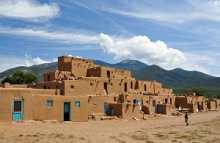Article
A large pueblo complex situated at the base of the Sangre de Cristo Mountains in northern New Mexico that has been continually inhabited for approximately 1,000 years. The inhabitants of Taos Pueblo are believed to be descended from the Ancestral Puebloans, and it is estimated that the construction of Taos Pueblo began sometime between 1000 and 1450 CE. Taos was first contacted by Europeans when Spanish explorers encountered the pueblo and its people in 1540. Taos Pueblo would become one of the strongholds of Pueblo resistance in the struggle against Spanish colonization along the Rio Grande and was home to leaders of the 1680 Pueblo Revolt, which saw Spanish settlers flee as far south as the settlement of El Paso. By the turn of the twentieth century, Taos Pueblo, its people, and its environs had become the subject of Western literary and artistic works, as the nearby town of Don Fernando de Taos became the destination for a group of American, European, and eventually Native American artists who coalesced into what became known as the Taos Soceity of Artists (1915-1927).
The Taos Pueblo was designated as an UNESCO World Heritage Site in 1992, a designation which acknowledges the physical and cultural significance of the site and its people.
"Taos Pueblo" by Kent Kanouse is licensed under CC BY-NC.
Manuscripts
References
Fowles, Severin M.
2013 An Archaeology of Doings: Secularism and the Study of Pueblo Religion. Santa Fe:
School for Advanced Research.
McAlduff, Casey
2011 Taos Pueblo. In Mancall, Peter C., ed. Encyclopedia of Native American History, vol. 3.
New York: Facts On File, Inc.
Meinen, Stephen
2011 Popé. In Mancall, Peter C., ed. Encyclopedia of Native American History, vol. 2.
New York: Facts On File, Inc.
Parsons, Elsie Worthington Clews
1970 Taos Pueblo. General Series in Anthropology, no. 2. New York: JohnReprint Corp.

